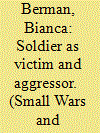|
|
|
Sort Order |
|
|
|
Items / Page
|
|
|
|
|
|
|
| Srl | Item |
| 1 |
ID:
160095


|
|
|
|
|
| Summary/Abstract |
Insomnia is prevalent among Veterans with post-traumatic stress disorder (PTSD), it exacerbates PTSD symptoms, and it contributes to impaired functioning and quality of life. To improve treatment outcomes, it is important to identify risk factors for insomnia and sedative-hypnotic use. Classification and regression trees and logistic regression models were used to identify variables associated with insomnia or sedative-hypnotic use. Key findings include low insomnia diagnosis rates (3.5–5.6%) and high rates of sedative-hypnotics (44.2–49.0%). Younger Veterans and those without a breathing-related sleep disorder (BRSD) were more likely to receive an insomnia diagnosis. Veterans with greater service connection and those with an alcohol/substance use disorder were more likely to be prescribed sedative-hypnotics. Interaction terms may have identified potential groups at risk of being under-diagnosed with insomnia (i.e. non-black Veterans with psychiatric co-morbidity, black Veterans without psychiatric co-morbidity) as well as groups at risk for sedative-hypnotic use (i.e. younger Veterans without BRSD). In sum, Veterans with PTSD have high rates of sedative-hypnotic use despite minimal evidence they are effective. This is counter to recommendations indicating behavioral interventions are the first-line treatment. Policy changes are needed to reduce use of sedative-hypnotics and increase access to behavioral insomnia interventions.
|
|
|
|
|
|
|
|
|
|
|
|
|
|
|
|
| 2 |
ID:
121812


|
|
|
|
|
| Publication |
2013.
|
| Summary/Abstract |
War causes trauma that can undo a warrior's character. Sophocles' Ajax is a good example of a traumatized warrior and some Afghanistan and Iraq veterans see striking parallels between contemporary conflicts and the Trojan War. With the United States increasingly facing asymmetrical enemies, there are now many traumatized soldiers and vets, not only suffering from posttraumatic stress disorder (PTSD) but also committing suicide. Combat stress, being central to warfare, has until now been incurable. Today, advanced military R&D projects aim to find a "magic pill" to forestall PTSD. Propranolol may be such a drug, as it could be used to prevent PTSD by "erasing" emotional memories. However, this attempt at pharmacoprevention raises many ethical questions. Most importantly, it threatens to instrumentalize away the existential element of war and to push warfare into a posthuman age. To better understand the challenges we are facing today, it is important not only to read Aldous Huxley's Brave New World but also to go back to the Greeks.
|
|
|
|
|
|
|
|
|
|
|
|
|
|
|
|
| 3 |
ID:
190719


|
|
|
|
|
| Summary/Abstract |
This article examines the subversion of the hero soldier figure in three Vietnam War films from three different nations that faced defeat in Vietnam: Coppola’s Apocalypse Now, Schoendoerffer’s Dien Bien Phu, and Jeong Ji-yeong’s White Badge. A close analysis reveals that all three films undermine the image of the virtuous and powerful hero soldier through recurring stylistic elements. Apocalypse Now, through the ‘Ride of the Valkyries’ helicopter sequence – as well as the opening and ending sequences – portrays the American soldier as a barbaric aggressor. Dien Bien Phu, meanwhile, visually undermines the image of the powerful hero soldier through cinematographic techniques which portray the French soldiers in the field as small and powerless. Finally, White Badge – which, unlike the two other films, takes place in the post-war period – subverts the image of the hero soldier through its use of auditory and visual elements to portray the Korean soldier as aggressor and, first and foremost, victim. The article concludes with a discussion of how the three films influence audiences’ perceptions of those who fought in Vietnam.
|
|
|
|
|
|
|
|
|
|
|
|
|
|
|
|
| 4 |
ID:
142527


|
|
|
|
|
| Summary/Abstract |
This article examines key setting events and personal factors that are associated with support for either non-violent activism or violent activism among Somali refugee young adults in the United States. Specifically, this article examines the associations of trauma, stress, symptoms of posttraumatic stress disorder (PTSD), posttraumatic growth (PTG), strength of social bonds, and attitudes towards legal and non-violent vs. illegal and violent activism. Structured interviews were conducted with a sample of Somali refugee males ages 18–25 living in the northeastern United States (N = 79). Data were analyzed using multiple linear regressions and path analysis. Greater exposure to personal trauma was associated with greater openness to illegal and violent activism. PTSD symptoms mediated this association. Strong social bonds to both community and society moderated this association, with trauma being more strongly associated with openness to illegal and violent activism among those who reported weaker social bonds. Greater exposure to trauma, PTG, and stronger social bonds were all associated with greater openness to legal non-violent activism.
|
|
|
|
|
|
|
|
|
|
|
|
|
|
|
|
| 5 |
ID:
188928


|
|
|
|
|
| Summary/Abstract |
Scholars of war and combat posit that soldiers are more willing to execute strikes on adversaries when they perceive lower risk to themselves or less connection with their targets. Accordingly, technologies like the drone, which drastically expands the distance between adversaries, should make it easier to strike decisively and without remorse. The empirical record tells a different story. Despite operating very far away from the battle theater, drone operators suffer PTSD at the same rate as pilots of manned aircraft. We argue that this unanticipated consequence of drone warfare stems from the unique way in which drone tactics marry spatial distance and temporal duration. Drone operators surveil their targets via detailed video footage for extended periods of time, both before and after firing, in order to identify or locate potential targets, to measure collateral risks, and afterward to assess a strike’s effectiveness. We argue that the clarity and duration of this surveillance tempers any advantage derived from ‘distance’. Spatial distance protects drone operators from enemy fire but temporal proximity exposes them to greater emotional costs of killing than previously thought. Indeed, prolonged observation temporally extends ‘contact’ and mitigates the dehumanizing effects imputed to distance. This unexpected effect highlights a shifting ethical dilemma. In the formulation of the ‘naked soldier’, combatants in a just war deserve respect due to shared vulnerability. Yet while spatial distance physically protects the drone operator, it also requires that they identify vulnerable and legitimate targets through contemporary timing practices that establish intimate knowledge of that target and may thus denude and even heighten the operator’s emotional vulnerability. While others have argued that contemporary wartime features technologies and tactics that undercut conventions about legitimate combat, we uncover an emerging ethical problem in moral and psychological harms associated with the way that drone warfare trades space for time.
|
|
|
|
|
|
|
|
|
|
|
|
|
|
|
|
|
|
|
|
|